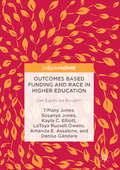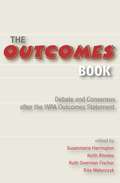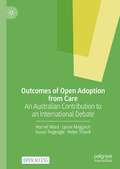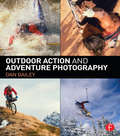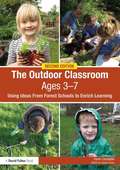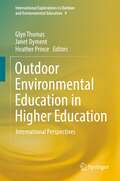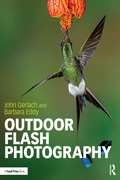- Table View
- List View
Outcomes Based Funding and Race in Higher Education: Can Equity be Bought?
by Tiffany Jones Sosanya Jones Kayla C. Elliott Latoya Russell Owens Amanda E. Assalone Denisa GándaraThis book examines how Performance or Outcomes Based Funding (POBF) policies impact racial equity in higher education. Over the last decade, higher education has become entrenched in a movement that holds colleges and universities more accountable to its supporters. There are pressures to answer questions about student outcomes and performance, the value of education, the effectiveness of instructors, and the ability of existing leaders to manage efficiently and effectively. It is within this climate that states have adopted POBF policies. Through POBF, public colleges and universities receive state funding through formulas that no longer rely solely on student enrollment, but are instead based on student outcomes. This book provides an overview for policymakers of how racial equity has been addressed, the impact of these approaches, and recommendations for moving forward.
Outcomes Based Funding and Race in Higher Education: Can Equity be Bought?
by Tiffany Jones Sosanya Jones Kayla C. Elliott Latoya Russell Owens Amanda E. Assalone Denisa GándaraThis book examines how Performance or Outcomes Based Funding (POBF) policies impact racial equity in higher education. Over the last decade, higher education has become entrenched in a movement that holds colleges and universities more accountable to its supporters. There are pressures to answer questions about student outcomes and performance, the value of education, the effectiveness of instructors, and the ability of existing leaders to manage efficiently and effectively. It is within this climate that states have adopted POBF policies. Through POBF, public colleges and universities receive state funding through formulas that no longer rely solely on student enrollment, but are instead based on student outcomes. This book provides an overview for policymakers of how racial equity has been addressed, the impact of these approaches, and recommendations for moving forward.
Outcomes-Based Program Review: Closing Achievement Gaps In- and Outside the Classroom With Alignment to Predictive Analytics and Performance Metrics
by Marilee J. Bresciani LudvikSecond EditionThis book introduces the reader to the principles of assessment of student learning outcomes in the context of program review, and illustrates how to implement a sustainable outcomes-based assessment program review process based on over 30 case studies of exemplary practice across a range of institutional types.Since publication of the first edition just over a decade ago, the landscape of higher education has been transformed. With the emergence of competency-based education, the questioning of the value of a post-secondary degree, the explosion of neuroscientific research, the emphasis on metacognition, as well as demographic changes in who is going to college and why, new questions are being asked and new methods of collecting data have multiplied. This new edition retains the goals of the first--which is to inform institutional self-reflection of how well the organization is achieving its intended purpose--in a manner that is reflective, adaptive, and collaborative, but which recognizes today’s changed environment.Among the new topics Marilee J. Bresciani Ludvik introduces in this edition is how to appropriately connect outcomes-based program review (OBPR) to performance indicators and predictive analytics and develop meaningful new performance metrics to inform our understanding of the student experience. She also addresses the intersection of OBPR with competency-based assessment, introduces the reader to new concepts and terminology, and demonstrates the implications of neuroscientific research for learning and development and how that influences OBPR design. All the cases, a signature feature of the first edition to illustrate best practice, have been replaced for this edition.Bresciani Ludvik postulates the importance of developing institutions as learning organizations where OBPR is designed collaboratively between student services, academic services, business services professionals, and faculty.Each chapter concludes with key learning points as well as questions for organizational leadership to promote ongoing professional development as institutions implement OBPR practices that are appropriate for their specific contexts.
Outcomes-Based Program Review: Closing Achievement Gaps In- and Outside the Classroom With Alignment to Predictive Analytics and Performance Metrics
by Marilee J. Bresciani LudvikSecond EditionThis book introduces the reader to the principles of assessment of student learning outcomes in the context of program review, and illustrates how to implement a sustainable outcomes-based assessment program review process based on over 30 case studies of exemplary practice across a range of institutional types.Since publication of the first edition just over a decade ago, the landscape of higher education has been transformed. With the emergence of competency-based education, the questioning of the value of a post-secondary degree, the explosion of neuroscientific research, the emphasis on metacognition, as well as demographic changes in who is going to college and why, new questions are being asked and new methods of collecting data have multiplied. This new edition retains the goals of the first--which is to inform institutional self-reflection of how well the organization is achieving its intended purpose--in a manner that is reflective, adaptive, and collaborative, but which recognizes today’s changed environment.Among the new topics Marilee J. Bresciani Ludvik introduces in this edition is how to appropriately connect outcomes-based program review (OBPR) to performance indicators and predictive analytics and develop meaningful new performance metrics to inform our understanding of the student experience. She also addresses the intersection of OBPR with competency-based assessment, introduces the reader to new concepts and terminology, and demonstrates the implications of neuroscientific research for learning and development and how that influences OBPR design. All the cases, a signature feature of the first edition to illustrate best practice, have been replaced for this edition.Bresciani Ludvik postulates the importance of developing institutions as learning organizations where OBPR is designed collaboratively between student services, academic services, business services professionals, and faculty.Each chapter concludes with key learning points as well as questions for organizational leadership to promote ongoing professional development as institutions implement OBPR practices that are appropriate for their specific contexts.
Outcomes Book: Debate and Consensus after the WPA Outcomes Statement
by Susanmarie Harrington Ruth Fischer Rita Malenczyk Keith RhodesThe WPA Outcomes Statement is important because it represents a working consensus among composition scholars about what college students should learn and do in a composition program. But as a single-page document, the statement cannot convey the kind of reflective process that a writing program must undertake to address the learning outcomes described. The Outcomes Book relates the fuller process by exploring the matrix of concerns that surrounded the developing Statement itself, and by presenting the experience of many who have since employed it in their own settings.
Outcomes, Learning And The Curriculum: Implications For Nvqs And Other Qualifications
by John BurkeThis book provides an account of the curricular consequences of the outcomes approach to education (NVQs GNVQs etc). It contains contributions from leading experts in the field and, as such, is likely to become the core text in this area. An initial discussion of the main themes leads the reader into a discussion of key ideas and the theory behind the Outcomes approach covering, in addition, issues concerning standards and quality. Areas of the curriculum covered include assessment, modularization, flexible learning and work-based learning, higher level competences and the autonomous learner. It should be of interest to all concerned with the development of the curriculum, ranging from school sixth forms through further and higher education to professional industrial trainers with an interest in the development of education and training in the UK.
Outcomes, Learning And The Curriculum: Implications For Nvqs And Other Qualifications
by John BurkeThis book provides an account of the curricular consequences of the outcomes approach to education (NVQs GNVQs etc). It contains contributions from leading experts in the field and, as such, is likely to become the core text in this area. An initial discussion of the main themes leads the reader into a discussion of key ideas and the theory behind the Outcomes approach covering, in addition, issues concerning standards and quality. Areas of the curriculum covered include assessment, modularization, flexible learning and work-based learning, higher level competences and the autonomous learner. It should be of interest to all concerned with the development of the curriculum, ranging from school sixth forms through further and higher education to professional industrial trainers with an interest in the development of education and training in the UK.
Outcomes, Learning And The Curriculum: Implications For Nvqs, Gnvqs And Other Qualifications
by John BurkeThis book provides an account of the curricular consequences of the outcomes approach to education (NVQs GNVQs etc). It contains contributions from leading experts in the field and, as such, is likely to become the core text in this area. An initial discussion of the main themes leads the reader into a discussion of key ideas and the theory behind the Outcomes approach covering, in addition, issues concerning standards and quality. Areas of the curriculum covered include assessment, modularization, flexible learning and work-based learning, higher level competences and the autonomous learner. It should be of interest to all concerned with the development of the curriculum, ranging from school sixth forms through further and higher education to professional industrial trainers with an interest in the development of education and training in the UK.
Outcomes, Learning And The Curriculum: Implications For Nvqs, Gnvqs And Other Qualifications
by John BurkeThis book provides an account of the curricular consequences of the outcomes approach to education (NVQs GNVQs etc). It contains contributions from leading experts in the field and, as such, is likely to become the core text in this area. An initial discussion of the main themes leads the reader into a discussion of key ideas and the theory behind the Outcomes approach covering, in addition, issues concerning standards and quality. Areas of the curriculum covered include assessment, modularization, flexible learning and work-based learning, higher level competences and the autonomous learner. It should be of interest to all concerned with the development of the curriculum, ranging from school sixth forms through further and higher education to professional industrial trainers with an interest in the development of education and training in the UK.
Outcomes: Nvqs And The Emerging Model Of Education And Training
by Gilbert JessupJessup's widely acclaimed book provides explanations of the many facets of National Vocational Qualifications: who they are for, why they have been developed, how they work, and the benefits they confer. The author explains how NVQs relate to a wide range of issues in education and training.
Outcomes: Nvqs And The Emerging Model Of Education And Training
by Gilbert JessupJessup's widely acclaimed book provides explanations of the many facets of National Vocational Qualifications: who they are for, why they have been developed, how they work, and the benefits they confer. The author explains how NVQs relate to a wide range of issues in education and training.
Outcomes of Open Adoption from Care: An Australian Contribution to an International Debate
by Harriet Ward Lynne Moggach Susan Tregeagle Helen TrivediThis Open Access book presents unique evidence from the first comprehensive study of the outcomes of open adoption from care in Australia. It contributes to the international debate concerning the advantages and disadvantages of face-to-face post adoption contact with birth families.The chapters assess whether adoption provides a better chance of permanence and more positive outcomes than long-term foster care for abused and neglected children in care who cannot safely return to their birth families. They also explore whether open adoption can avoid some of the detrimental consequences of past policies in which adoption was shrouded in secrecy and children frequently grew up with a conflicted sense of identity. The book will appeal to policy makers, practitioners and students of social policy, social work, the law, psychology and psychiatry. It should also be of interest to adult adoptees and adoptive parents, whose experiences it reflects.
Outdoor Action and Adventure Photography
by Dan BaileyThe difference between getting the shot and missing the shot comes down to split seconds and how you manage your gear and your technique. In Outdoor Action and Adventure Photography professional adventure sports photographer Dan Bailey shows readers how to react quickly to unfolding scenes and anticipate how the subject and the background might converge. Capturing those significant moments to produce powerful imagery that evoke the feel and mood of adventure requires specialized skills and a wide variety of creative ideas. This book teaches photographers how to think geometrically and how to pull together the elements that make for a successful shot, all while being immersed in the action. The practical manual will improve your technique for creating more compelling adventure imagery, whether you’re shooting ultra-marathoners splattered in mud, rock climbers in a crevasse, or mountain bikers hurtling past you. In this book, you’ll: • Discover the necessary equipment for shooting action, learn how to use it to its full potential, and develop a comprehensive adventure photography camera system that you can adapt to different shooting situations. • Learn specific techniques and creative ideas that help you freeze the moment and create images that convey excitement, mood, and the feel of adventure. • Learn advanced skills that can help you start defining your own particular style of action photography and create a "brand" of photography that’s based around your passion and your vision. • Examine case studies that break down the process for shooting different types of action subjects and see the nuts and bolts of how to create powerful imagery from start to finish.
Outdoor Action and Adventure Photography
by Dan BaileyThe difference between getting the shot and missing the shot comes down to split seconds and how you manage your gear and your technique. In Outdoor Action and Adventure Photography professional adventure sports photographer Dan Bailey shows readers how to react quickly to unfolding scenes and anticipate how the subject and the background might converge. Capturing those significant moments to produce powerful imagery that evoke the feel and mood of adventure requires specialized skills and a wide variety of creative ideas. This book teaches photographers how to think geometrically and how to pull together the elements that make for a successful shot, all while being immersed in the action. The practical manual will improve your technique for creating more compelling adventure imagery, whether you’re shooting ultra-marathoners splattered in mud, rock climbers in a crevasse, or mountain bikers hurtling past you. In this book, you’ll: • Discover the necessary equipment for shooting action, learn how to use it to its full potential, and develop a comprehensive adventure photography camera system that you can adapt to different shooting situations. • Learn specific techniques and creative ideas that help you freeze the moment and create images that convey excitement, mood, and the feel of adventure. • Learn advanced skills that can help you start defining your own particular style of action photography and create a "brand" of photography that’s based around your passion and your vision. • Examine case studies that break down the process for shooting different types of action subjects and see the nuts and bolts of how to create powerful imagery from start to finish.
Outdoor and Experiential Learning: An Holistic and Creative Approach to Programme Design
by Andy Martin Dan FrancOutdoor and experiential learning has advanced in leaps and bounds over the last 20 years. Educators and developers in the Czech and Slovak Republics have been unexpected leaders in the field; the result of isolation of the country under communism and a unique mix of culture and geography. This book offers a guide to the theory and techniques, pioneered by the Czechs and Slovaks, including the concept of dramaturgy, a process involving elements of learning psychology, role play and theatre that concentrates on physical, social, creative and reflective/emotional learning states. It also includes a full set of guidelines for designing outdoor and experiential events, along with complete instructions for 30 games. The authors provide design opportunities to be more creative in the development of young people, as well as older learners and those involved in corporate management education.
Outdoor and Experiential Learning: An Holistic and Creative Approach to Programme Design
by Andy Martin Dan FrancOutdoor and experiential learning has advanced in leaps and bounds over the last 20 years. Educators and developers in the Czech and Slovak Republics have been unexpected leaders in the field; the result of isolation of the country under communism and a unique mix of culture and geography. This book offers a guide to the theory and techniques, pioneered by the Czechs and Slovaks, including the concept of dramaturgy, a process involving elements of learning psychology, role play and theatre that concentrates on physical, social, creative and reflective/emotional learning states. It also includes a full set of guidelines for designing outdoor and experiential events, along with complete instructions for 30 games. The authors provide design opportunities to be more creative in the development of young people, as well as older learners and those involved in corporate management education.
The Outdoor Classroom Ages 3-7: Using Ideas From Forest Schools To Enrich Learning
by Karen ConstableThis fully revised edition of Understanding the Danish Forest School Approach is a much needed source of information for those wishing to extend and consolidate their understanding of the Danish Forest School Approach. It enables analysis of the essential elements of this particular approach to early childhood teaching and the relationship it holds with quality early years practice. Describing the key principles of the Forest School Approach to early childhood, and heavily supported with practical examples and case studies, each chapter ends with highlighted key points, followed by reflections on practice to aid discussion and reflection on own practice. Including a new chapter on the curriculum, this text explores all aspects of the approach including: The geographical, historical, social and cultural influences that have shaped the philosophy and pedagogy of the early years setting in Denmark. The people and theories that have influenced and supported the practices of using the outdoors with children. An analysis of the learning environments, their risks and challenges and what a learning environment is made up of. The Danish early years curriculum; the areas of learning and the way pedagogues facilitate the learning processes. Parental, political and research perspectives on the approach and the sustainability of its future. Understanding the Danish Forest School Approach highlights the key ideas that practitioners should consider when reviewing and reflecting on their own practice, and outlines the national appraisals and evaluations of the curriculum. Providing students and practitioners with key information about a major pedagogical influence on early years practice, this is a vital text for students, early years and childcare practitioners, teachers, early years professionals, children’s centre professionals, lecturers, advisory teachers and setting managers.
The Outdoor Classroom Ages 3-7: Using Ideas From Forest Schools to Enrich Learning
by Karen ConstableEmphasising the importance of continuity for young children, The Outdoor Classroom Ages 3–7 practically demonstrates how early years settings and schools can maximise the learning potential of the outdoor environment. Fully updated to take into account the revised EYFS and Key Stage 1 curricula and including new case studies throughout, this second edition encourages teachers and practitioners to examine and reflect on their use of the outside area to ensure they provide rich play opportunities for children that will further their learning regardless of time, space or financial restraints. Drawing on the Forest School approach, this handy text considers the practical implications for settings using the outdoor classroom and covers: the characteristics of effective learning outdoors; guidance on timetabling and planning; advice on the logistics and health and safety involved; tips for navigating parental and staff opposition; closely linked theory and practice to assessment; the social and emotional aspects of learning. Full of resources, lesson plans and activities to support rich learning opportunities, this book will inspire you to think creatively about the outside area and use its full potential to bring the outdoors alive with interest, exploration and challenge.
The Outdoor Classroom Ages 3-7: Using Ideas From Forest Schools to Enrich Learning
by Karen ConstableEmphasising the importance of continuity for young children, The Outdoor Classroom Ages 3–7 practically demonstrates how early years settings and schools can maximise the learning potential of the outdoor environment. Fully updated to take into account the revised EYFS and Key Stage 1 curricula and including new case studies throughout, this second edition encourages teachers and practitioners to examine and reflect on their use of the outside area to ensure they provide rich play opportunities for children that will further their learning regardless of time, space or financial restraints. Drawing on the Forest School approach, this handy text considers the practical implications for settings using the outdoor classroom and covers: the characteristics of effective learning outdoors; guidance on timetabling and planning; advice on the logistics and health and safety involved; tips for navigating parental and staff opposition; closely linked theory and practice to assessment; the social and emotional aspects of learning. Full of resources, lesson plans and activities to support rich learning opportunities, this book will inspire you to think creatively about the outside area and use its full potential to bring the outdoors alive with interest, exploration and challenge.
The Outdoor Classroom in Practice, Ages 3–7: A Month-By-Month Guide to Forest School Provision
by Karen ConstableThe outdoor environment is an integral part of many early years settings and schools, but is it being used to its full potential? The Outdoor Classroom in Practice, Ages 3-7 offers guidance on how the outdoors can be used to teach and challenge children across a range of settings by drawing on forest school practice. Following a month-by-month format, it explores theme-related play experiences, planning, evaluations of how the ideas described were carried out and what impact they had on children's learning and development. This fully updated second edition includes: over 150 new full-colour photographs to illustrate practice activities and objectives for both early years and KS1, including links to indoor play discussion and support for those working with children with special educational needs detailed information on the role of the adult and of the environment sections covering health and safety guidelines and specific risk assessment in all chapters Written by a leading authority on forest school practice, this book aims to inspire and help practitioners make the most of the outdoor environment all year round.
The Outdoor Classroom in Practice, Ages 3–7: A Month-By-Month Guide to Forest School Provision
by Karen ConstableThe outdoor environment is an integral part of many early years settings and schools, but is it being used to its full potential? The Outdoor Classroom in Practice, Ages 3-7 offers guidance on how the outdoors can be used to teach and challenge children across a range of settings by drawing on forest school practice. Following a month-by-month format, it explores theme-related play experiences, planning, evaluations of how the ideas described were carried out and what impact they had on children's learning and development. This fully updated second edition includes: over 150 new full-colour photographs to illustrate practice activities and objectives for both early years and KS1, including links to indoor play discussion and support for those working with children with special educational needs detailed information on the role of the adult and of the environment sections covering health and safety guidelines and specific risk assessment in all chapters Written by a leading authority on forest school practice, this book aims to inspire and help practitioners make the most of the outdoor environment all year round.
Outdoor Education: A Pathway to Experiential, Environmental, and Sustainable Learning (Palgrave Studies in Alternative Education)
by Stephen T. SchrothThis book explores the phenomenon of outdoor education, an approach that permits children from all backgrounds to explore environmental, sustainability, and other issues facing them and their communities. Organized around both the conceptual and the practical issues facing school leaders interested in outdoor education, the book provides a wealth of resources for those interested in implementing outdoor education in their schools or classrooms. Infinitely flexible, outdoor education provides a lens through which teachers may explore any content area with any age group of children. Providing readers with both the theoretical underpinnings that support place-based curriculum as well as practical ways to implement an outdoor education program, the book also provides seven case studies that examine the issues facing school leaders desiring to make such a change. Outdoor Education: A Pathway to Experiential, Environmental, and Sustainable Learning guides those interested in exploring outdoor education through the curricular, instructional, and policy considerations needed to accomplish this goal.
Outdoor Environmental Education in Higher Education: International Perspectives (International Explorations in Outdoor and Environmental Education #9)
by Heather Prince Glyn Thomas Janet DymentThis book brings together an international group of authors to discuss the outdoor environmental education (OEE) theory and practice that educators can use to support teaching and learning in higher education. The book contents are organised around a recently established list of threshold concepts that can be used to describe the knowledge and skills that university students would develop if they complete a major in outdoor education. There are six key sections: the theoretical foundations and philosophies of OEE; the pedagogical approaches and issues involved in teaching OEE; the ways in which OEE is a social, cultural and environmental endeavour; how outdoor educators can advocate for social justice; key approaches to safety management; and the need for on-going professional practice. The threshold concepts that form the premise of the book describe outdoor educators as creating opportunities for experiential learning using pedagogies that align their programme’s purpose and practice. Outdoor educators are place-responsive, and see their work as a social, cultural and environmental endeavour. They advocate for social and environmental justice, and they understand and apply safety principles and routinely engage in reflective practice. This book will provide clarity and direction for emerging and established outdoor educators around the world and will also be relevant to students and professionals working in related fields such as environmental education, adventure therapy, and outdoor recreation.
Outdoor Environmental Education in the Contemporary World (International Explorations in Outdoor and Environmental Education #12)
by Jan Činčera Bruce Johnson Daphne Goldman Iris Alkaher Michal MedekThis edited volume explores the role of outdoor environmental education in the contemporary society. It identifies some of the opportunities and challenges of this educational area, particularly in the growing digitalization of the contemporary society and the distancing between people and nature. Furthermore, it seeks to answer why outdoor environmental education is essential for developing students’ environmental citizenship competencies or developing their relationship with nature. The book also introduces the various approaches existing in the field, discusses their relevance, and highlights their unique features. The book finishes with an overview of the practice of outdoor environmental education in selected countries from North America, Europe, and Asia.
Outdoor Flash Photography
by John Gerlach Barbara EddyMaximizing the power of your camera’s flash is difficult enough in a studio set-up, but outdoors literally presents a whole new world of challenges. John Gerlach and Barbara Eddy have taken the most asked about subject from their renowned photography workshops and turned it into this guidebook that is sure to inspire your next outdoor shoot, while also saving you time and frustration. Outdoor Flash Photography covers a range of practices from portrait to landscape, including unique strategies that the authors have pioneered through 40 years in the field. Mastering the use of multiple flashes to freeze action is shown through one of most challenging subjects in nature, hummingbirds in flight. This book will benefit photographers of all experience levels who are eager to evolve their outdoor photography and get the most out of their equipment.
